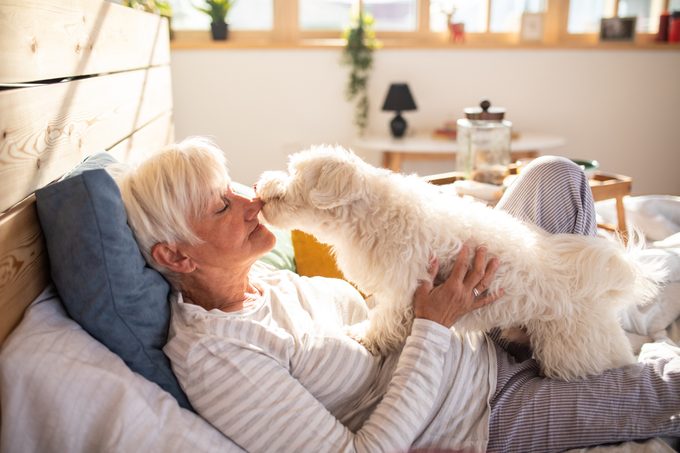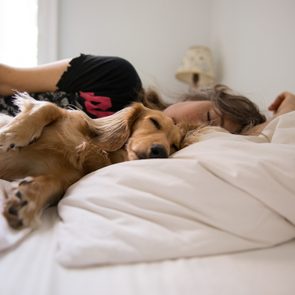Everything Veterinarians Want You to Know About Hypoallergenic Dogs
Updated: Oct. 10, 2022
The idea of a dog that doesn't cause allergies is compelling—but the truth is that even hypoallergenic dogs can trigger reactions. But that doesn't mean you have to give up on dog ownership entirely.
Four-legged friends and allergies
One in three American households has at least one dog. Yet one in 10 Americans suffers from dog-related allergies.
Those numbers help explain the interest in hypoallergenic dogs—the idea that you can have a loyal furry friend that won’t trigger allergy symptoms.
The key thing to remember is that hypoallergenic just means “less likely to provoke allergies”—not allergen-free. Hypoallergenic dog breeds tend to be pups that don’t shed as much as other breeds.
It is true that some dog breeds may be better than others for someone allergic or sensitive to dogs, which is good news for those who want to reap the health benefits of owning a dog.
But there’s no such thing as an allergen-free dog: Here’s what you need to know about dog allergies and hypoallergenic dogs.
What are allergies?
Your immune system usually does a great job at spotting dangerous intruders and attacking them before they can start an infection.
Allergies occur when someone’s immune system develops sensitivities to certain proteins in the environment that aren’t actually a problem—like pollen or dust.
Allergic symptoms occur when the immune response overreacts to these benign substances.

Why do dogs cause allergies?
Many people mistakenly think that dog hair itself causes allergies. But it turns out dog hair is only the vehicle dog allergens stick to and travel on.
“People with pet allergies have over-sensitive immune systems where they can react to proteins in the pet’s urine, saliva, or dander (dead skin cells),” says Melanie Carver, chief mission officer of the Asthma and Allergy Foundation of America.
“It’s important to keep in mind that pet hair is not an allergen. It’s what collects in pet hair and comes off of animals,” she explains. “Your pets can also carry other allergens like dust and pollen in hair or fur.”
Pet allergens can be anywhere—and everywhere
The bad news for people allergic to dogs is that dog dander can be found almost everywhere.
Dog and cat allergen proteins found in dander, saliva, and urine can even be found in homes or places where pets have never lived, according to Darryl Zeldin, MD, the scientific director of the National Institute of Health and the National Institute of Environmental Health Sciences (NIH/NIEHS).
That is likely because pet allergens be carried from one environment to another on people’s clothing or other items such as bags, furniture, footwear, or suitcases.
Dander and other pet allergens can stick to nearly any household surface, where they often remain until you do intensive vacuuming or cleaning. And pet allergens stick around quite a long time.
“These allergens hold onto their strength over long periods of time, up to several months,” Carver says. “They can also be easily stirred [up] when grooming pets, dusting, vacuuming, and doing other household chores and activities.”
Once in the air, pet allergens can remain there for a long time given their small molecular size.
Experts explain that this small particle size also helps dog allergens get deep in people’s lungs, making them more likely to cause a respiratory response.
Symptoms of minor to moderate allergies
Although the immune system is attempting to destroy and clear foreign proteins, it can cause a series of symptoms.
Someone’s allergic response depends on the severity of their allergy and the amount of exposure. But common minor to moderate allergy symptoms include:
- sneezing and runny nose
- itchy nose and eyes
- watering eyes
- rashes and hives (patches of red, round, raised bumps that are very itchy)
- minor cough
- sore throat
- bloating
- stomach cramps, vomiting, and diarrhea
- red, itchy skin where a dog licked or scratched the skin
If your allergy to dogs is fairly minor, you may not develop symptoms until after a few days of exposure to dog allergens. However, people with moderate dog allergies often develop symptoms much sooner after exposure, often within a matter of minutes.
Symptoms of severe allergies
Most people only experience minor symptoms when exposed to allergens. But some can develop extreme reactions that can be life-threatening.
Signs of a serious allergy include:
- skin swelling and pain
- tongue swelling
- swelling to the extent that the throat closes up
- severe rash, especially on the neck, upper chest, and face
- coughing or wheezing (making a whistling sound when breathing)
- having a hard time breathing or catching your breath
- a feeling of dread or impending doom
- feeling faint or passing out
People with severe allergies typically develop symptoms within 15-30 minutes after exposure to dog allergens.
Seek medical attention if severe signs of allergies occur. Also, seek medical attention if any allergy symptoms do not improve when someone is no longer exposed to an allergen or responds to medications.
Are hypoallergenic dogs really hypoallergenic?
The consensus from experts is that there is no such thing as a truly hypoallergenic dog because all dogs release certain allergen proteins, specifically a protein known as Can f 1 (for Canis familiaris).
Because the protein can be found in a dog’s saliva, urine, blood, or skin cells, even a hairless or furless dog cannot be hypoallergenic.
“More and more people are told they are buying or getting a ‘hypoallergenic’ animal,” says Richard F. Lockey, MD, professor of medicine in the Division of Allergy and Immunology at University of South Florida Morsani College of Medicine. He stresses that the dogs can still trigger a reaction
Hypoallergenic dogs have less hair or shed less frequently, reducing the chances of causing allergies in people with allergies.
“Breeds that are considered ‘hypoallergenic’ are breeds with hair coats that do not shed, or shed very little,” says Maggie Brown-Bury, MD, DVM, emergency and critical care veterinarian and Canadian Veterinary Medical Association, Newfoundland and Labrador Council representative.
“Because they do not shed, the dander is not spread around the home the way it is with a pet that sheds a lot, and people in the home suffer [fewer] allergy symptoms.”
(This is why it feels good to look into your dog’s eyes.)
Best dog breeds for people with dog allergies, by size
Even though no dog breed is truly hypoallergenic, some breeds are more likely to a better fit for people with allergies than others based on their hair or shedding cycle.
Some breeds also carry certain traits or characteristics that may make them better suited for some people, households, and lifestyles than others.
The American Kennel Club (AKC) lists many hypoallergenic breeds. But it is important to keep in mind that smaller dogs tend to create fewer allergens given that they produce less hair and dander because of their size.
“Big dogs produce more dander and saliva,” says AKC’s Chief Veterinary Officer, Jerry Klein, DVM. “Small dogs also tend to be faster to bathe and groom, two things that may reduce the [number] of allergens in the home”
But not everyone will match up with the vibe or energy of a small dog. Here are some breeds Dr. Klein recommends for people looking for dogs less likely to cause allergies with descriptions from the AKC:
Small dogs
American Hairless Terrier
A hairless breed is a good consideration with families that want an active, trainable smaller dog. This breed is great at agility challenges.
Bedlington Terrier
With the looks of a lamb but the tenacity of a terrier, Bedlingtons require grooming to maintain their look, but they do not shed and are devoted family members.
Bichon Frise
Personable and energetic, but bichons do require grooming to maintain their crisp white coats.
Maltese
Tiny, delicate, and charming with a single white glamourous silky coat that requires maintenance to keep up their appearance.
Hairless Chinese Crested
Hairless varieties of Chinese Crested dogs only have hair on their tail, head, and ankles. That means they shed less hair than most breeds. Chinese Crested dogs are small, intelligent, and sensitive dogs with an ancient history.
Xoloitzcuintli
This beautiful hairless breed comes from Mexico in three different size variations.
Coton de Tulear
Small, white, and with a characteristic type of coat. Great personalities.
Medium-sized dogs
Kerry Blue Terrier
This dog is an all-around Irish terrier of medium size with a wavy blue-gray coat. This breed is smart, people-oriented, and alert.
Lagotto Romagnolo
The famous “truffle” breed sniffs out truffles in their native Italy. Medium size, smart, and active with a wavy to curly coat.
Peruvian Inca Orchid (Hairless)
An ancient hairless breed that originated in Peru. This breed is affectionate, noble, and loyal.
Spanish Water Dog Rare
Curly-type hair, medium-sized, work-oriented, and upbeat versatile dog. Rare in America but gaining popularity.
Large dogs
Afghan Hound
These hounds are elegant and dignified with long flowing hair that requires much grooming but does not shed very much. They are also known for their loyalty, affection for their humans, and sensitivity.
Irish Water Spaniel
An Irish sporting water dog with a shorter brown curly coat. Energetic and clownish, playful, hardworking, and brace.”Ideal for a sporting active family,” says
Poodle
A versatile, intelligent solid-colored dog that comes in three varieties: toy, miniature, and standard. Many that have searched for certain “hybrid” breeds should consider the original. Other mixed breeds are not likely to be quite as hypoallergenic as pure breeds.
Portuguese Water Dog
Related to poodles, this water dog is a versatile, active dog owned by the Obama family. The breed comes in different colors and combinations.
Soft Coated Wheaten Terrier
The versatile, medium golden terrier is a great family dog. This breed is active, friendly, deeply devoted to its humans, and athletic.
Barbet
New to America, this friendly and sweet-natured bred is currently rare but adorable.
Tips for managing dog allergies
The best way to manage dog allergy symptoms is to stop them from developing. That means the only real way to prevent dog allergy symptoms is to not be around dogs, have them in the home, or visit homes or other environments where dogs are or live.
If someone avoids contact with dogs, they may not need to take management medications.
But many people, especially those with severe allergies, may need to be preventatively treated all the time because it is nearly impossible to control exposure to dog allergens given how prevalent they are in the environment.
According to Dr. Zeldin, many people are able to control their allergy symptoms using antihistamines that are available over-the-counter. If they have complicating conditions, such as asthma, they may also require inhaled medications such as steroid inhalers.
People with dog allergies who still want pets can consider adopting or rescuing an animal they are not allergic to. This may mean choosing a pet without hair or dander, such as fish or reptiles.
Always make sure to always choose animals sourced from a known, legal origin and species that are not illegal, taken from the wild, or endangered.
Tips for dog owners with dog allergies
It’s upsetting for dogs and their human families if they have to find new homes because people are allergic to them.
But you might only discover you’re allergic to dogs after the pet has already established itself in your life.
Beyond that, dog allergens can persist in the environment for a long time, even once a dog is long gone. And it is nearly impossible to avoid dog allergens.
“Once the animal is eliminated from the home it can take up to five or six months before the animal allergens decrease to a level where they won’t trigger allergic symptoms in a cat or dog allergic subject,” Dr. Lockey says.
With this in mind, there are some ways people with dog allergies can try to reduce their symptoms if they decide to keep their dog.
Common tips include:
- Keep pets out of bedrooms or places someone spends a lot of time (offices, living rooms, etc.) and keep doors or entryways to these areas closed off.
- Clean areas someone spends a lot of time rigorously and frequently.
- Use HEPA air-cleaning devices, pet-friendly air purifiers, or those with electrostatic filters in bedrooms.
- Try to avoid carpeted floors or choose low pile options and steam clean them regularly.
- If floor coverings are needed chose to throw mats or rugs that can easily be washed in warm water.
- Try to keep surfaces and floors bare to make them easier to clean and less likely to hold dander and other pet allergens.
- Remove or aggressively clean pet’s favorite furniture, bedding, cloth toys, etc. that can hold onto allergens.
- Wear a dust mask while cleaning areas with pet allergens.
- Vacuum with a certified asthma & allergy friendly filter.
- Brush or groom dogs outdoors and clean crates, cages, or litter boxes outdoors.
- Cover bedroom vents with a dense material such as cheesecloth that can block out allergens spread by forced-air systems or air-conditioners.
- Clean your hands frequently and well after being around pets and do not touch the eyes or nose after being around or touching pets.
- Change clothing or footwear after being around pets or places they spend a lot of time.
Next, check out the best air purifiers for pets










![How to Massage Your Dog, According to Certified Dog Massage Therapists [With Instructional Video]](https://www.thehealthy.com/wp-content/uploads/2023/04/GettyImages-1357930308.jpg?resize=72,72)









